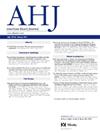Real-world exploration of LDL-cholesterol management in patients with atherosclerotic cardiovascular disease
IF 3.7
2区 医学
Q1 CARDIAC & CARDIOVASCULAR SYSTEMS
引用次数: 0
Abstract
Background
Although guidelines recommend low-density lipoprotein cholesterol (LDL-C) to be < 70 mg/dL in patients with atherosclerotic cardiovascular disease (ASCVD), the rate of achieving this goal remains suboptimal. We sought to understand real world contemporary practice patterns of LDL-C management in patients with ASCVD, and whether LDL-C testing influenced management across US health systems.
Methods
A retrospective cohort study utilizing electronic medical record data from five health systems participating in the CardioHealth Alliance was performed on patients with an LDL-C measurement in 2021 and prior ASCVD. Multivariable regression modeling was used to determine the relationship of clinical factors with achievement of guideline directed LDL-C target. Changes in lipid lowering therapy (LLT) after LDL-C testing were also described.
Results
Among 216,074 patients with ASCVD, 129,886 (60.1%) had uncontrolled LDL-C (i.e. ≥ 70 mg/dL). Compared with participants with controlled LDL-C (< 70 mg/dL), those with uncontrolled LDL-C were more frequently female (50.9% vs. 35.1%), or Black (13.7% vs. 10.3%), and less commonly had coronary artery disease as the form of vascular disease (73.0% vs. 83.5% %), heart failure (21.3% vs. 29.1% %), diabetes (34.1% vs. 48.2%), atrial fibrillation (19.3% vs. 26.1%), or chronic kidney disease (25.1% vs. 32.2%). In multivariable analyses, the factors most strongly associated with failure to achieve LDL-C control were female sex (RR 1.13 [95% CI 1.12-1.14] P < .001) and Black race (1.15 [1.14-1.17] P < .001). Among the 53,957 (41.5%) of those with uncontrolled LDL-C ≥70 mg/dL not on lipid lowering therapy (LLT) at baseline, only 21% were initiated on any LLT within 6 months of the uncontrolled LDL-C value.
Conclusions
Within 5 diverse large health systems in the CardioHealth Alliance, more than half of the patients with ASCVD had uncontrolled LDL-C with significant disparities based on sex and race at baseline. The vast majority were not initiated on any lipid lowering therapy within 6 months of an elevated test result indicating persistent gaps in care that will likely worsen health inequities in outcomes. This highlights the urgent need for implementation efforts to improve equitable care.
动脉粥样硬化性心血管疾病患者低密度脂蛋白胆固醇管理的真实世界探索。
背景:尽管指南建议对低密度脂蛋白胆固醇(LDL-C)进行测量,但该研究并没有对其进行评估:利用参加 CardioHealth 联盟的五个医疗系统的电子病历数据,对在 2021 年测量过低密度脂蛋白胆固醇并有 ASCVD 病史的患者进行了一项回顾性队列研究。研究采用多变量回归模型来确定临床因素与实现指南指导的 LDL-C 目标之间的关系。此外,还描述了低密度脂蛋白胆固醇检测后降脂治疗(LLT)的变化:在 216,074 名 ASCVD 患者中,129,886 人(60.1%)的低密度脂蛋白胆固醇未得到控制(即≥70 mg/dL)。与低密度脂蛋白胆固醇(LDL-C)已得到控制的患者相比(结论:低密度脂蛋白胆固醇(LDL-C)未得到控制的患者占60.1%:在 CardioHealth 联盟的五个不同的大型医疗系统中,一半以上的 ASCVD 患者的低密度脂蛋白胆固醇(LDL-C)未得到控制,且基线时的性别和种族差异显著。绝大多数患者在检测结果升高后的 6 个月内都没有开始接受任何降脂治疗,这表明护理方面的差距依然存在,很可能会加剧健康结果的不平等。这凸显了改善公平护理的迫切需要。
本文章由计算机程序翻译,如有差异,请以英文原文为准。
求助全文
约1分钟内获得全文
求助全文
来源期刊

American heart journal
医学-心血管系统
CiteScore
8.20
自引率
2.10%
发文量
214
审稿时长
38 days
期刊介绍:
The American Heart Journal will consider for publication suitable articles on topics pertaining to the broad discipline of cardiovascular disease. Our goal is to provide the reader primary investigation, scholarly review, and opinion concerning the practice of cardiovascular medicine. We especially encourage submission of 3 types of reports that are not frequently seen in cardiovascular journals: negative clinical studies, reports on study designs, and studies involving the organization of medical care. The Journal does not accept individual case reports or original articles involving bench laboratory or animal research.
 求助内容:
求助内容: 应助结果提醒方式:
应助结果提醒方式:


